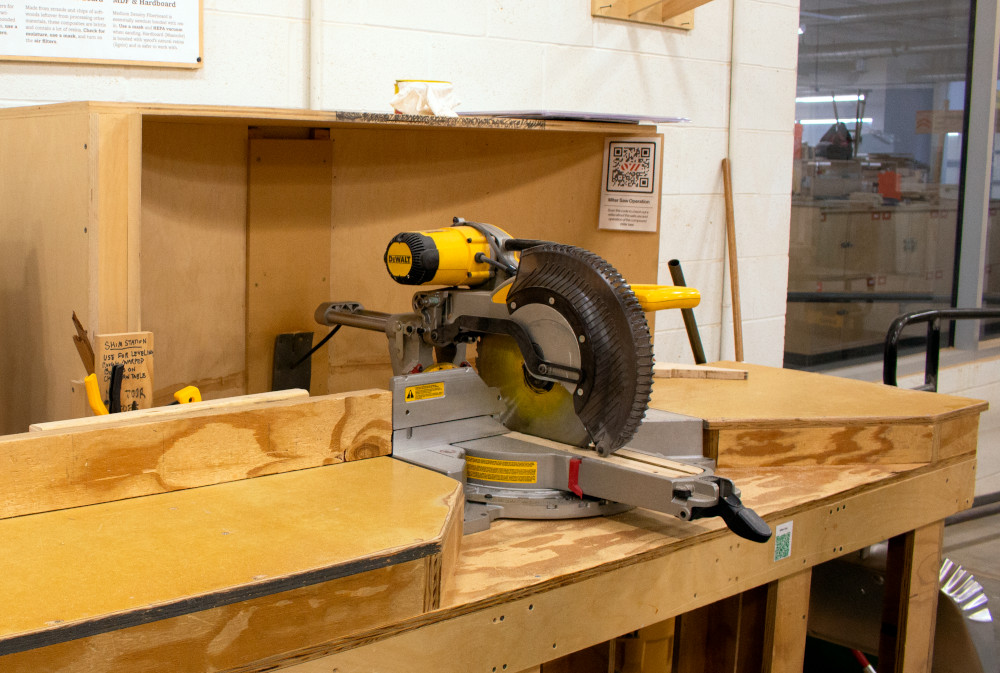
¶ Introduction
Open Works has a DWS780 12" Double Bevel Sliding Compound Miter Saw available for use.
¶ Shop Access
A membership or day pass is required to access the Wood Shop.
The Shop Safety Class Wood 1: Shop Safety is required to operate the Miter Saw.
¶ Machine Overview
The Miter Saw (also known as a "Chop Saw") is a power tool used for cross-cutting stock to size. The Miter Saw can cut at a traditional 90° angle, or the angle of the blade can be adjusted to create a bevel. The Miter Saw is capable of achieving compound angles on the stock.
¶ Machines Available
- Open Works has one DWS780 12" Double Bevel Sliding Compound Miter Saw.
¶ Machine Comparison
The Miter Saw is a more straight foward, and less dangerous, cutting instrument than other power tools like the Table Saw. Unlike the Table Saw, however; the Miter Saw can not rip down stock. When creating bevels, compound angles, or rough cutting stock up to 12" wide the Miter Saw is an excellent tool for the job. For extremely accurate cuts on larger stock the Table Saw is the preferred choice. When free hand cutting curves or angles you should use the Bandsaw.
| Tool | pros | cons |
|---|---|---|
| miter saw | good at big and thick pieces | tear out and harder to make a precise cut repeatedly |
| frame cutter | very precise cuts, little to no tear out, almost no kerf | maximum size of work piece is pretty small due to the physical effort required to cutter larger/thicker pieces |
¶ Parts of the Machine
The miter saw has a lot of parts, so there are several labled diagrams here as well as detailed diagrams where needed.
Click to see the operating handle side of the machine.
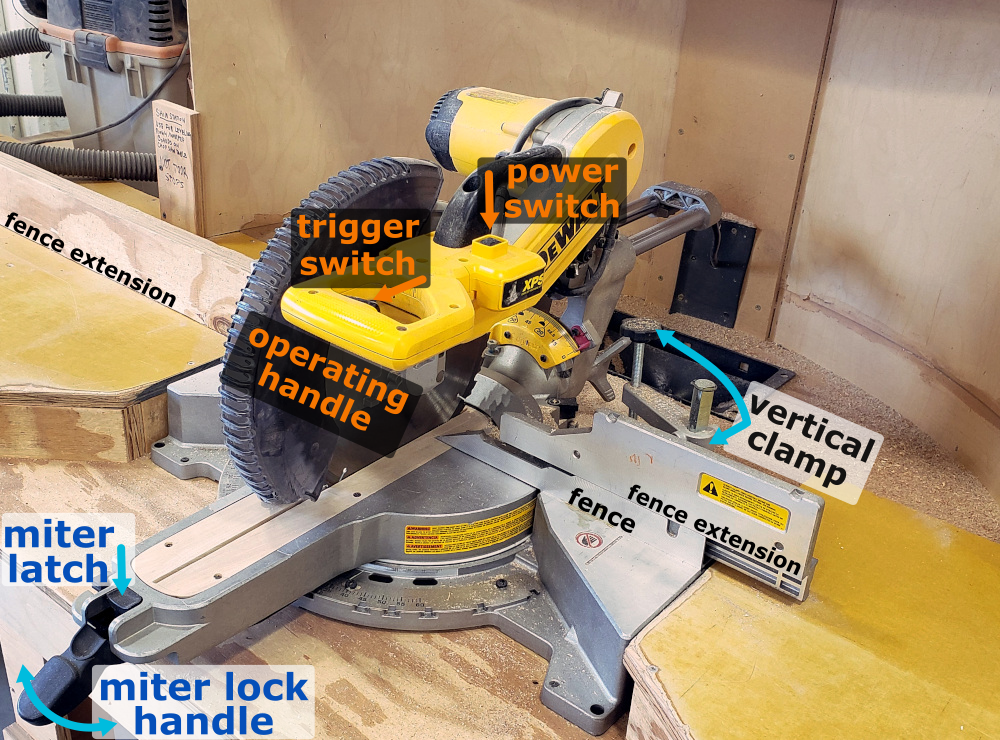
Click to see the left side of the machine, with the operating handle release marked.

Click to see the bevel knobs on the back of the machine.
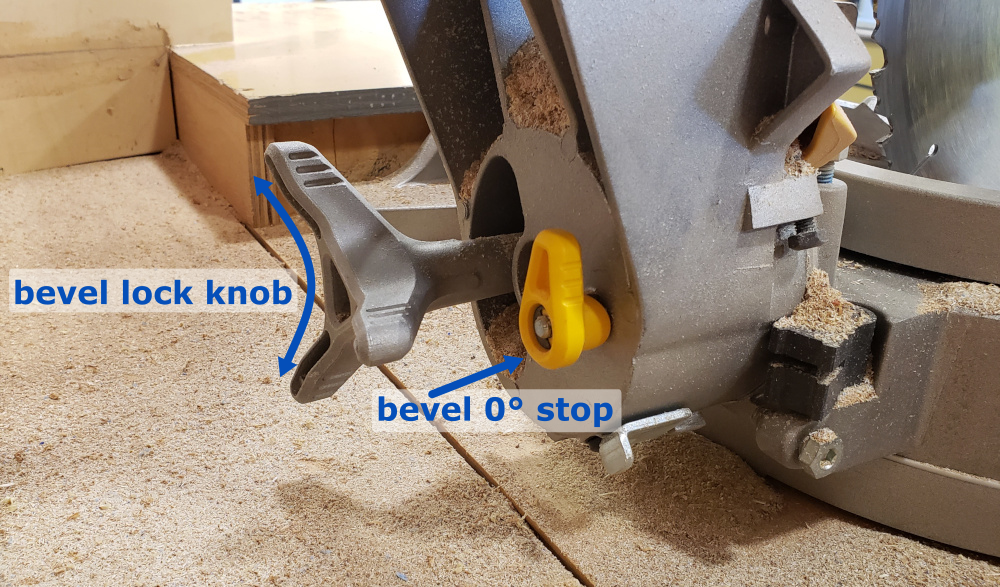
¶ Material Considerations
¶ Acceptable Materials:
Hardwoods.
Softwoods.
Plywood.
Formaldehyde-free MDF.
Hardboard.
Formaldehyde-free OBS.
Particle board.
¶ Use with Caution and Proper Technique:
Always check moisture levels with the moisture meter and look for nails with the metal detector.
Reclaimed lumber.
Logs.
Slabs.
Green wood.
Wooden dowel rods.
¶ FORBIDDEN MATERIALS:
DO NOT, under any circumstances, cut the following materials on the table saw:
Pressure treated wood.
Materials containing or coated with lead or lead-based paint.
Materials treated with formaldehyde.
Any pre-finished woods (for example: finished flooring, old bar tops, etc.).
Metal.
Glass.
¶ Machine Reservations
- A machine reservation is not required to use the Miter Saw.
¶ Safety
Personal Protective Equipment (PPE):
Sturdy, close-toed shoes must be worn at all times.
Long hair, jewelry, and loose clothing must be tied back.
Safety glasses and earmuffs must be worn while machines are running.
A dust mask or a NIOSH certified respirator is recommended.
For more information on shop safety visit Wood Shop under "Safety."
¶ Holding the Material and Hand Positioning
Always hold the workpiece tightly against the table and fence when cutting.
When possible, use the vertical clamp to secure the workpiece to the table.
When possible, you may also use a horizontal clamp to secure the workpiece to the fence. Be sure that the clamp does not cross the path of the blade.
Always use proper hand position as shown in the top half of the illustration.
Never cross arms, as shown in the bottom half of the illustration.
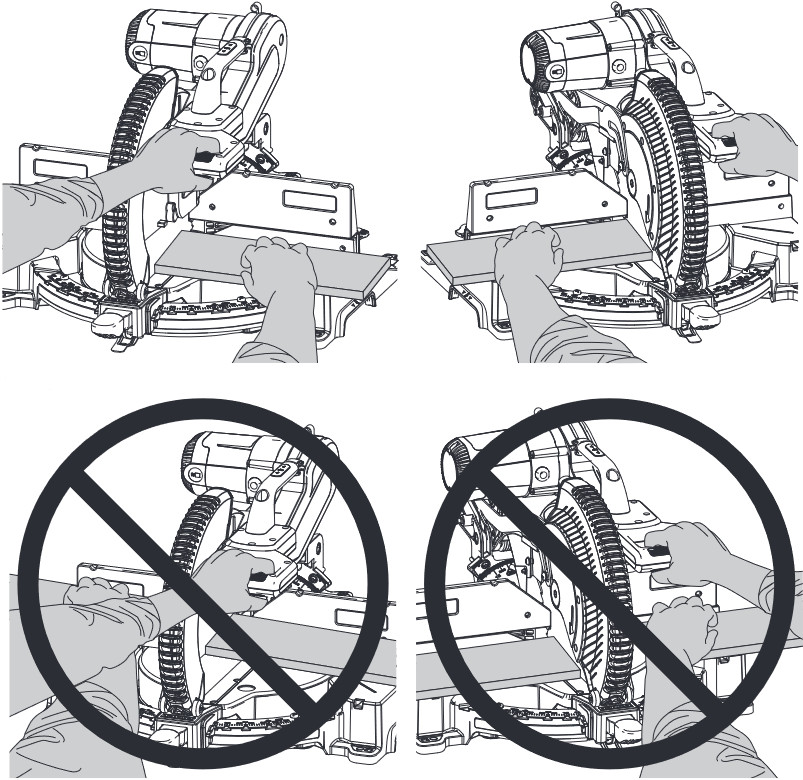 |
| Illustration adapted from the DWS780 user manual. |
Never place hands near the cutting area. Never place hands closer than 4" to the blade.
Be alert to where your thumb is in relation to the blade.
| Danger Zone | Illustration of hand placement | |
|---|---|---|
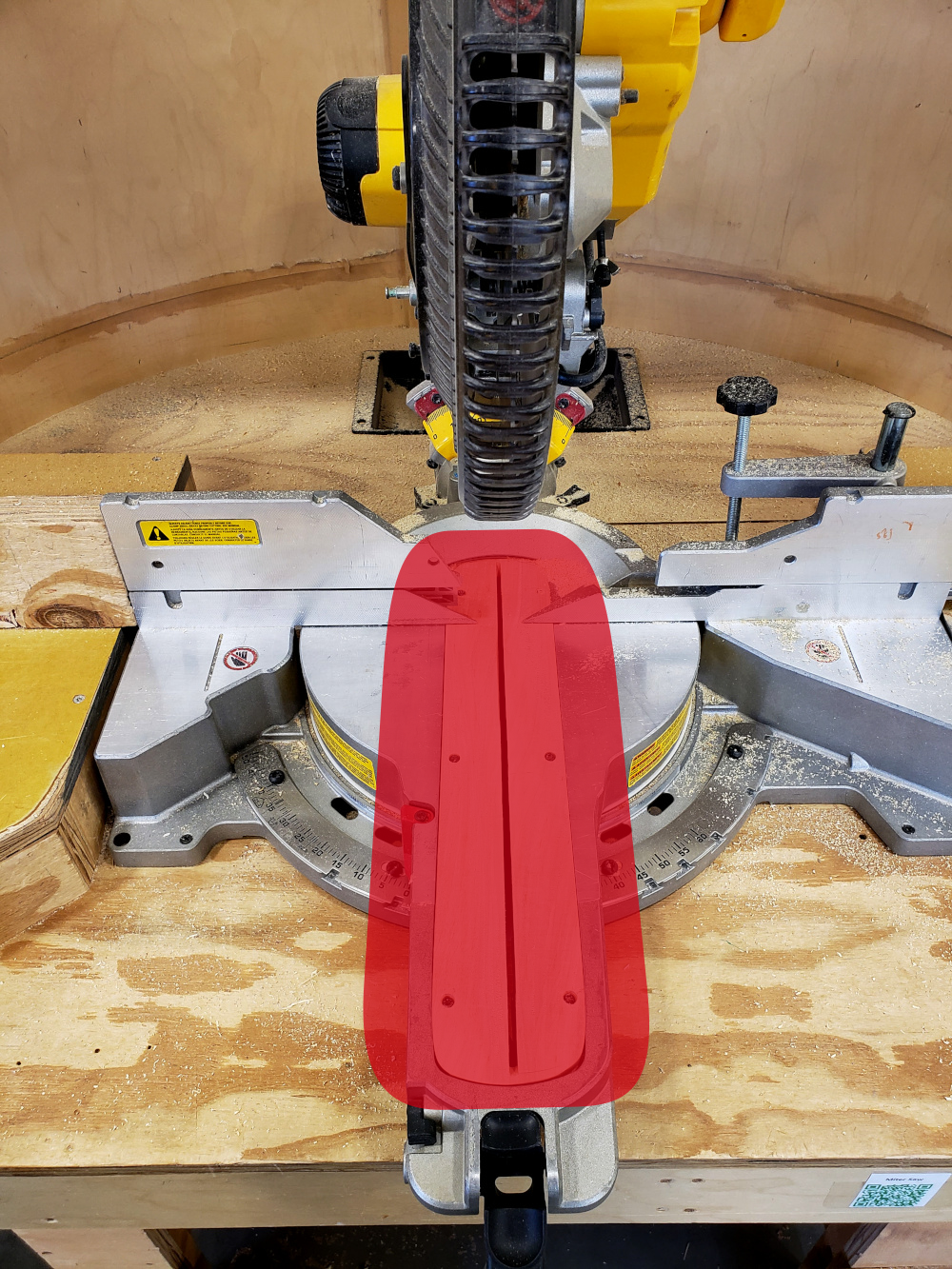 |
Incorrect hand placement | 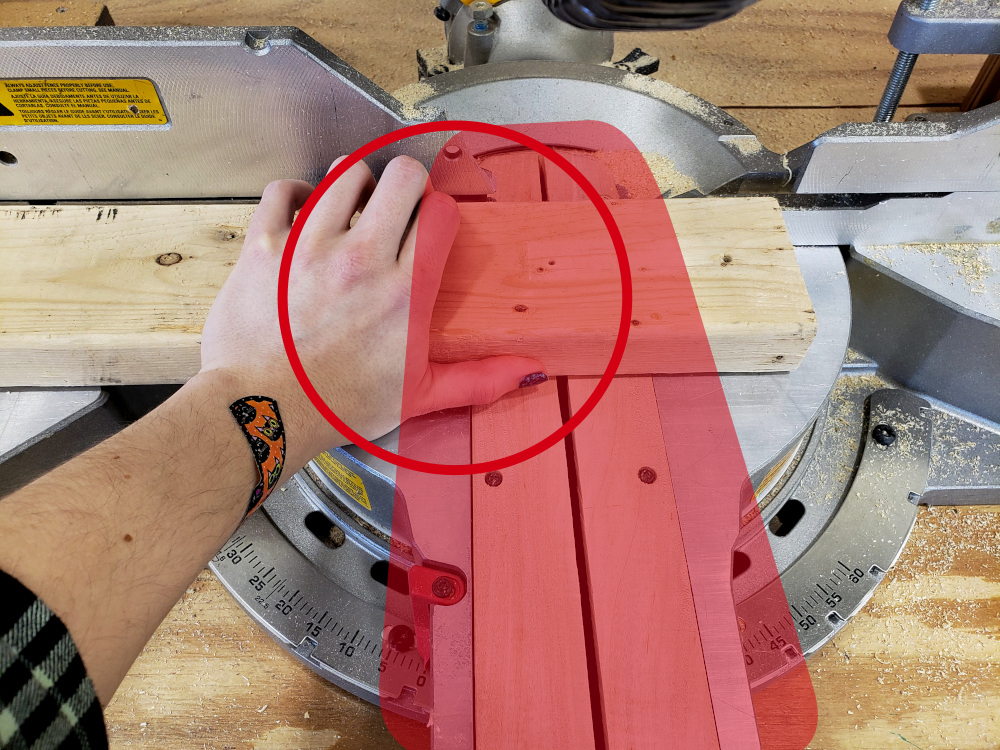 |
| Correct hand placement | 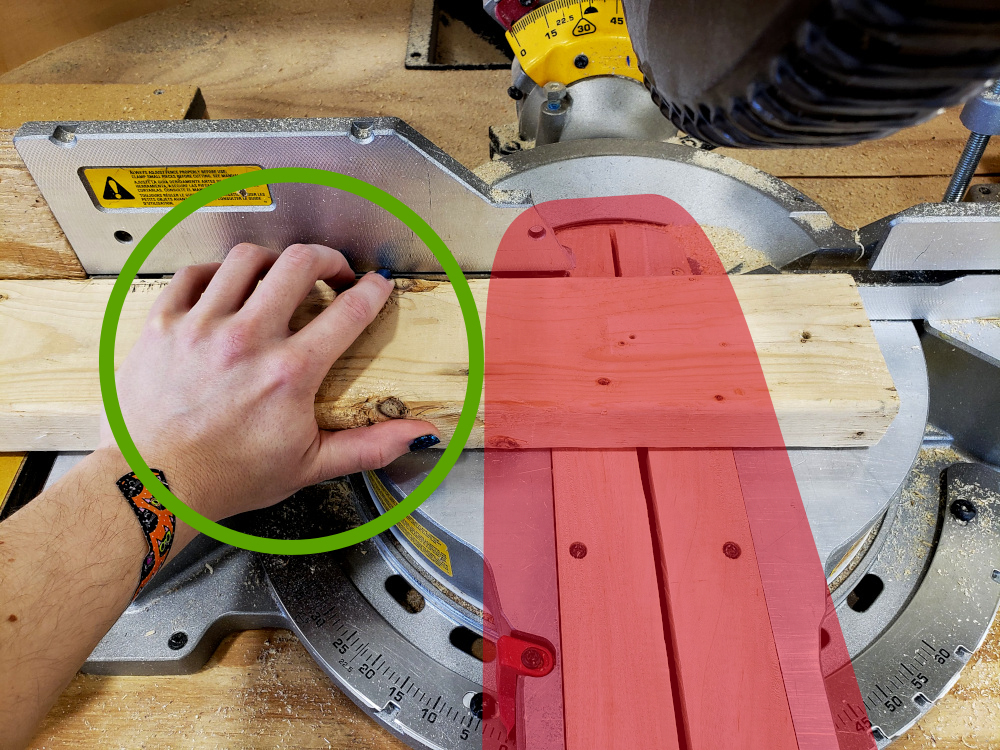 |
¶ Kickback
Kickback is when part of the workpiece is propelled back towards the operator at a high speed.
Kickback can
- throw the material into the air!
- throw the material at the operator, causing bruises or puncture wounds!
- shatter the material and throw the splinters everywhere!
- and more!
The possibility of kickback can never be eliminated, but it can be reduced.
Kickback can be caused by many things. Kickback is often caused by
- the blade binding in the material.
- the blade catching it in some way.
The possibility of binding is increased by attempting to cut warped wood and pieces that are too small.
The blade can catch the material if the material moves during the cut. The risk of the material moving can be reduced by holding it firmly against the table and fence. The risk can be reduced by using clamps, especially for large (material) or long (time) cuts.
Keep hands in position and the material secure until the trigger has been released and the blade has completely stopped.
¶ Step-by-Step Guides
¶ Before You Begin
¶ Using the Machine
¶ Machine Maintenance
All machine maintenance pages are only accessible by Staff. All machine maintenance is only to be done by Staff.
¶ Troubleshooting
All troubleshooting pages are only accessible by Staff. All troubleshooting is only to be done by Staff.
¶ References
DWS780 12" Double Bevel Sliding Compound Miter Saw Instruction Manual